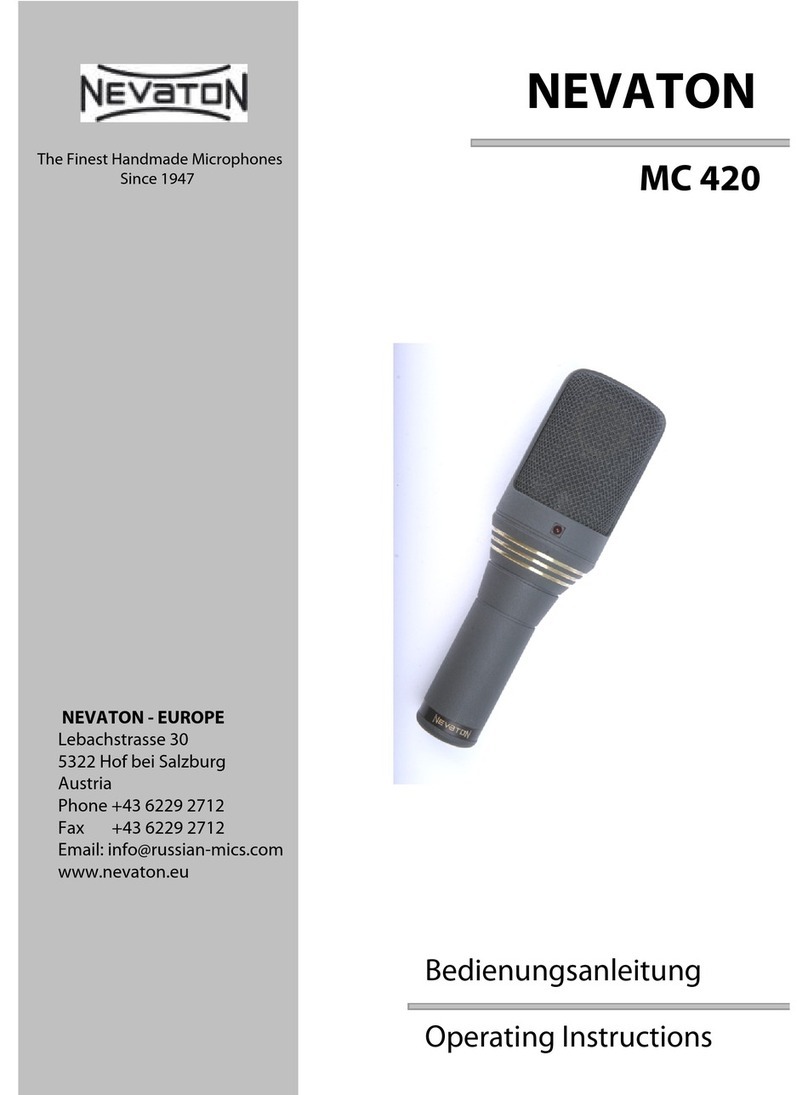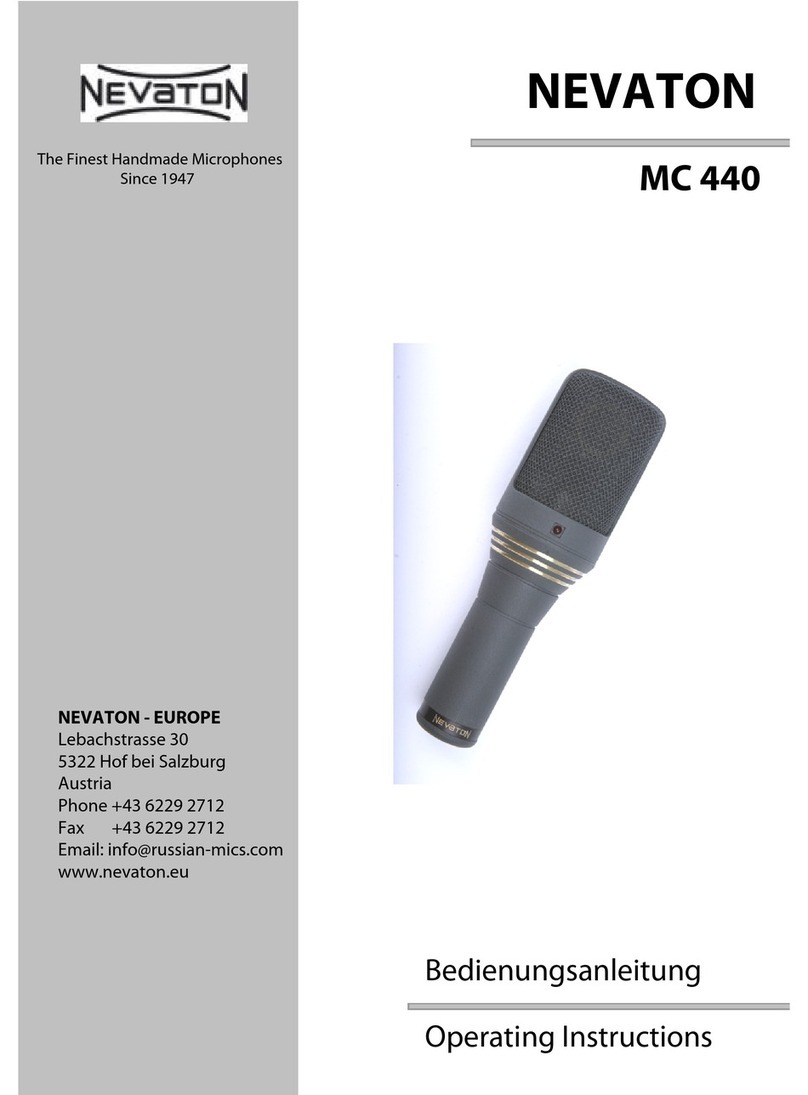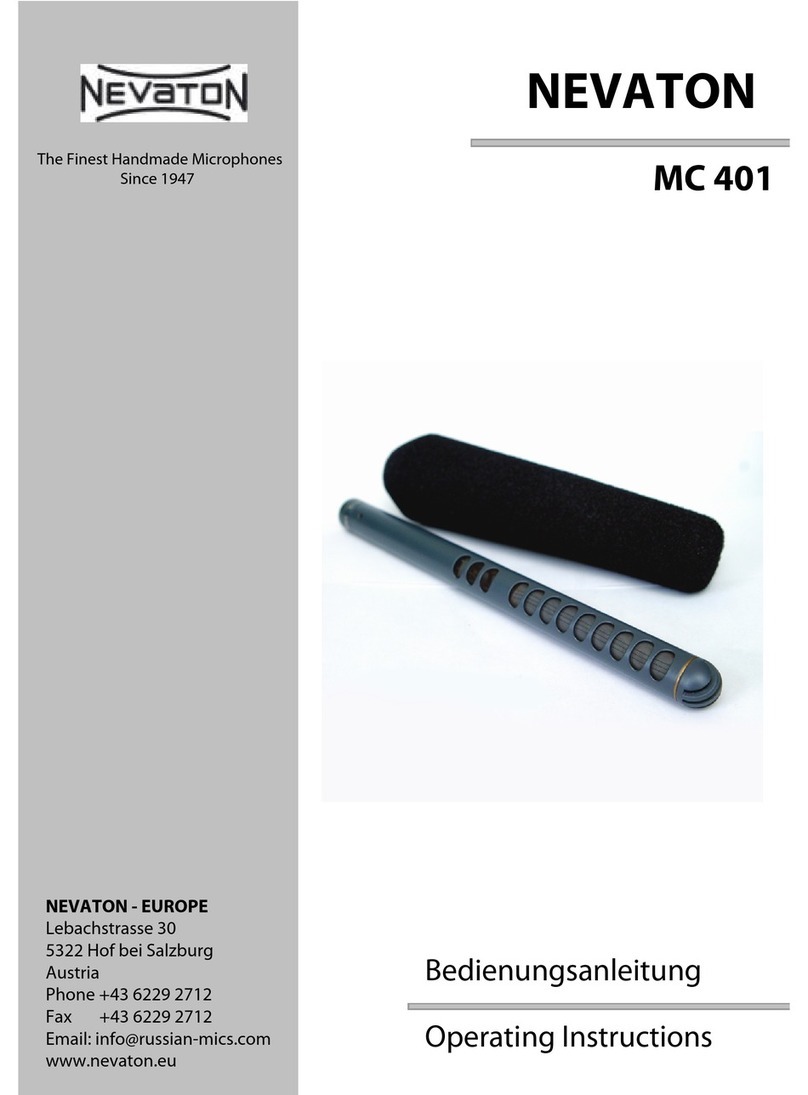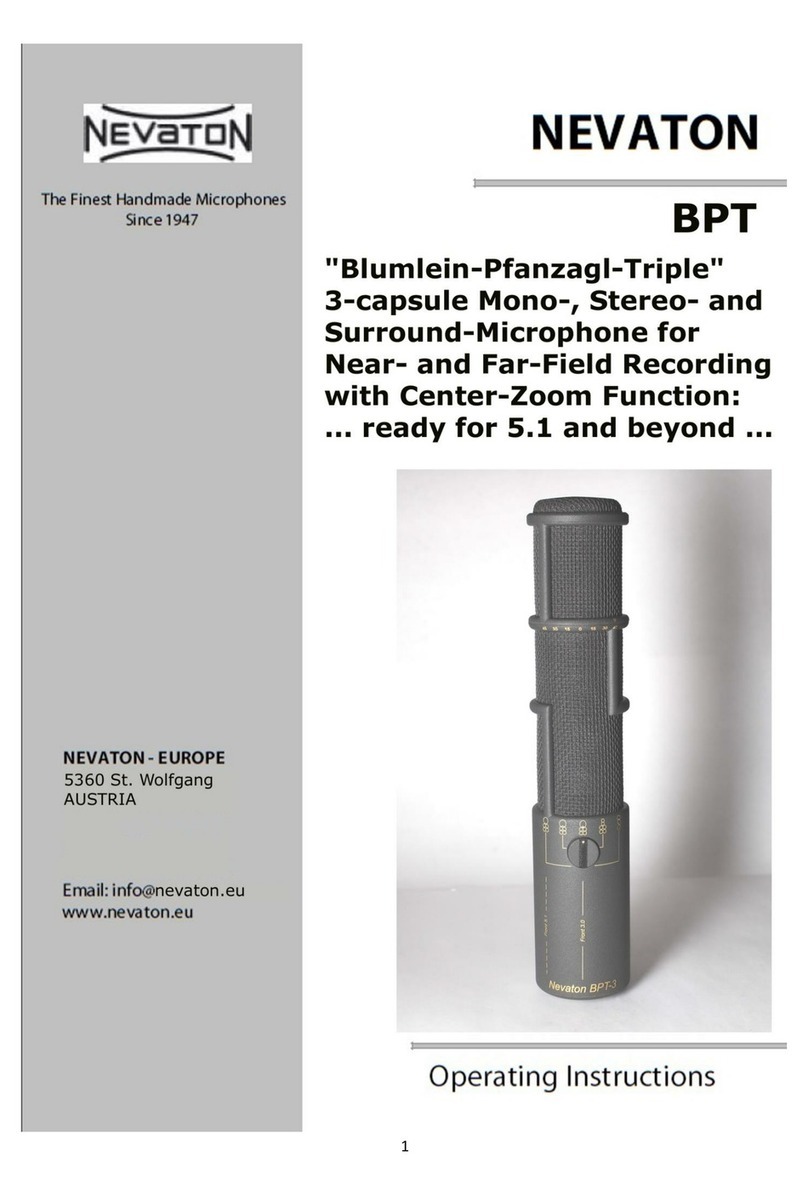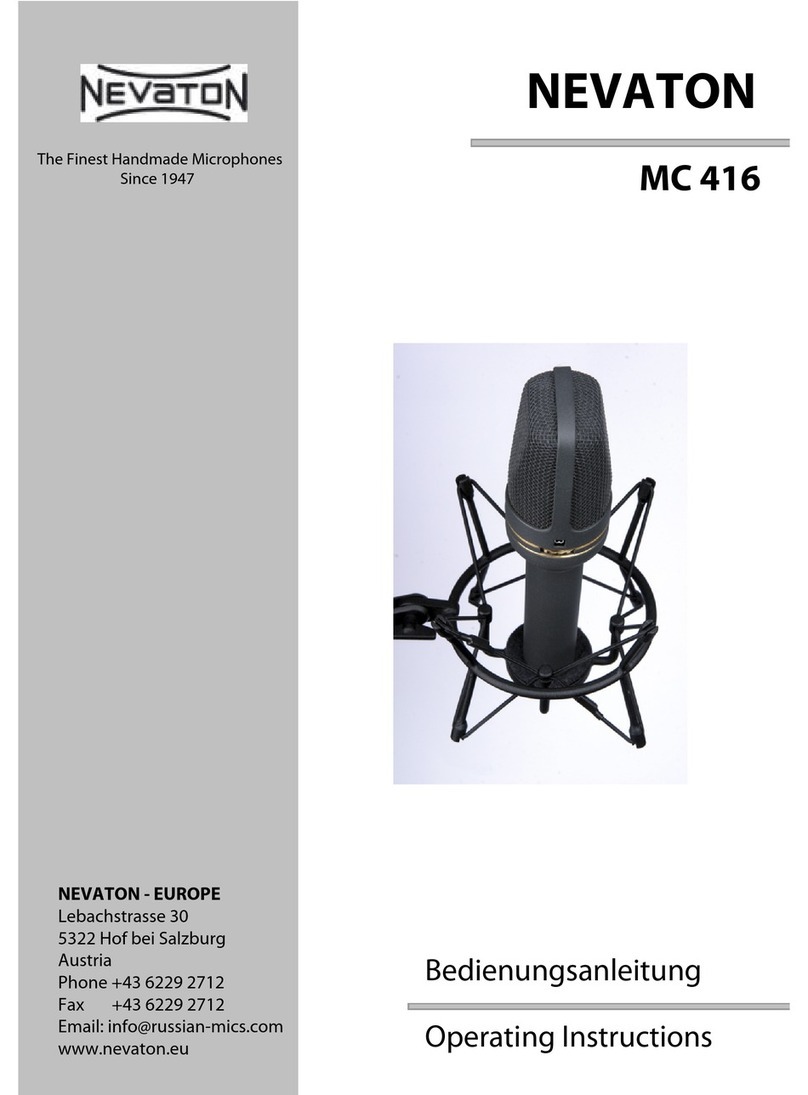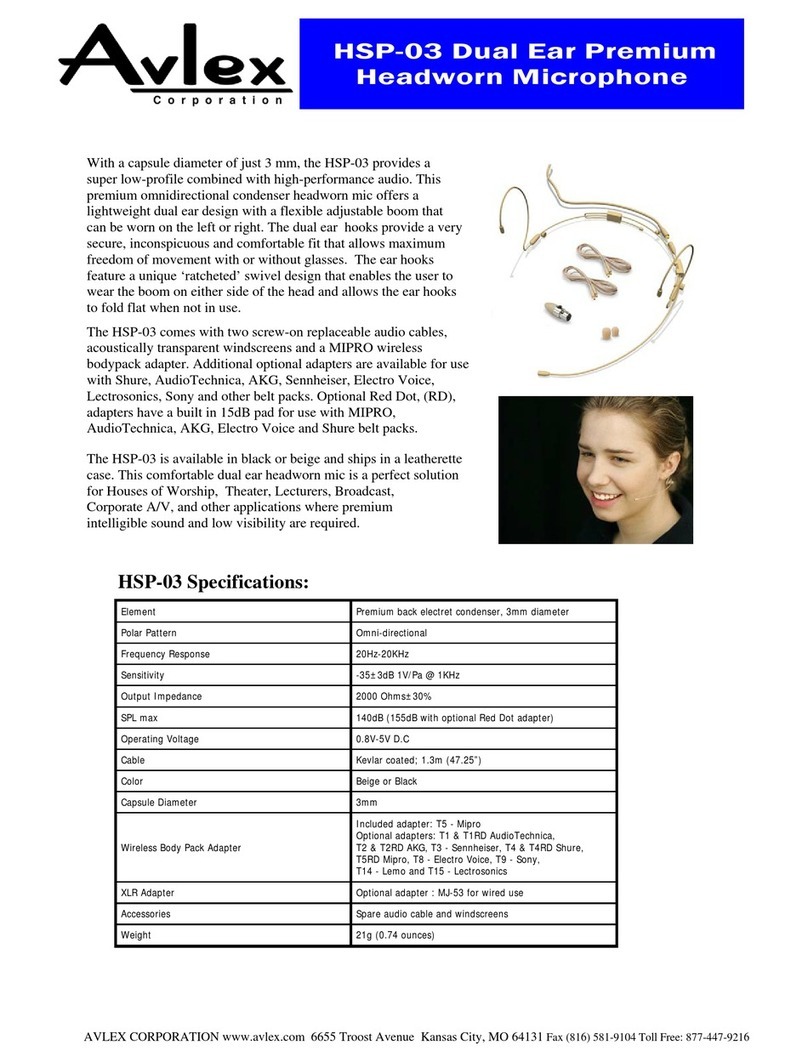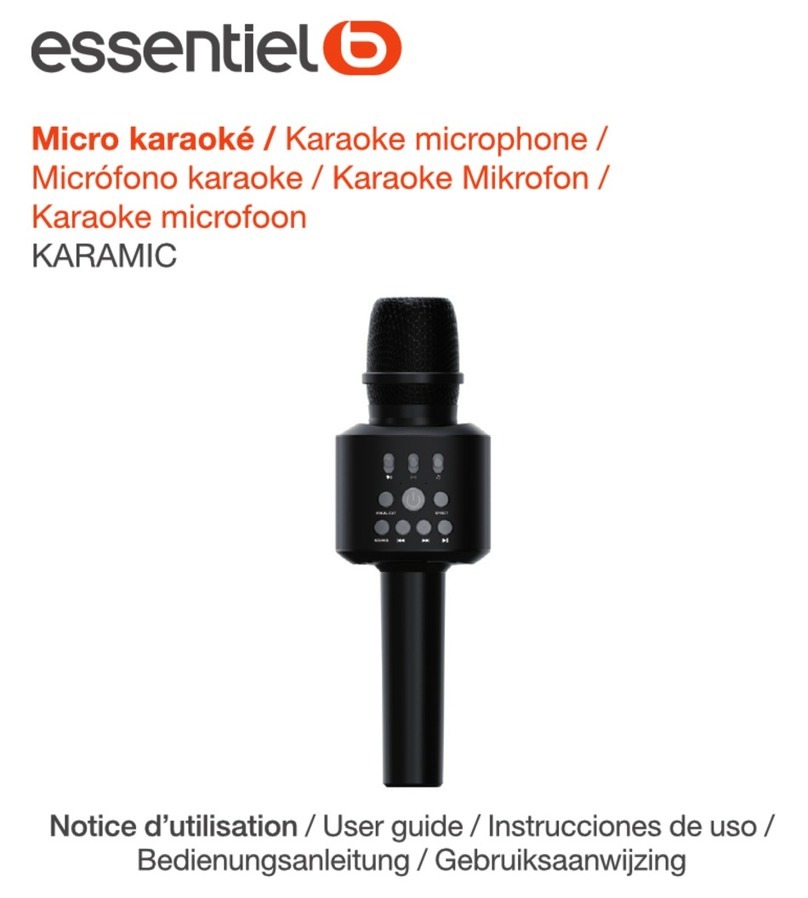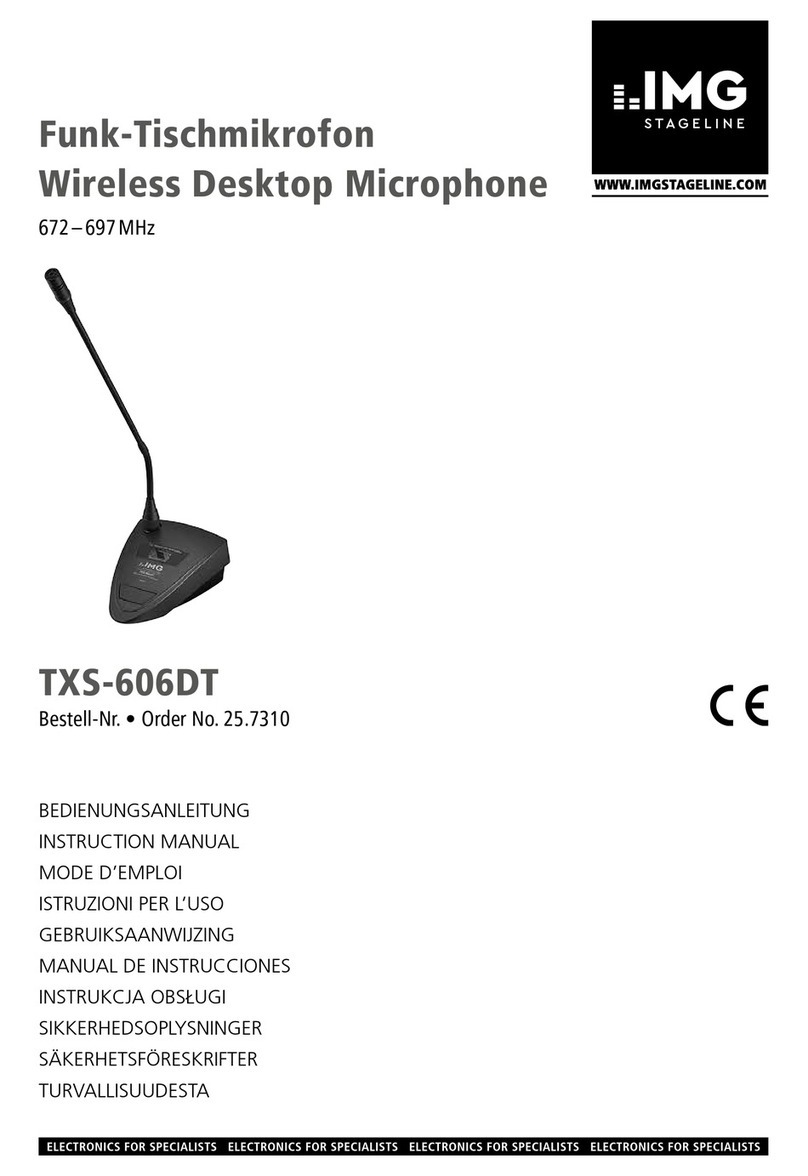NEVATON MC 404 User manual

Bedienungsanleitung
Operating Instructions
NEVATON
MC 404
NEVATON - EUROPE
Lebachstrasse 30
5322 Hof bei Salzburg
Austria
Phone +43 6229 2712
Fax +43 6229 2712
Email: [email protected]
www.nevaton.eu
The Finest Handmade Microphones
Since 1947

3
2
Table of Contents
1. The Dual-diaphragm Stereo
Condenser Microphone MC 404
Inhaltsverzeichnis
1. Description
2. Powering Technik
3. MC 404 Operting Modes
4. Technical Specifications
5. Frequency Range
The Nevaton MC 404 is a stereo condenser
microphone, which can be also used in
mono-mode where it provides you with
advanced multi-pattern functions.
The MC 404 features one 28mm-dual-
diaphragm symmetrical transducer.
Each of the capsula`s two diaphragms has its
own, respective amplifier channel.
The ultra-thin and gold-coated diaphragms
are made of Poly-Ethylene-Tereftalate-film. It
has excellent transient responses, a very low
self-noise level (-12 dB-A) and can handle
high sound pressure levels up to 134 dB.
All components of the capsulas have passed
a special artificial ageing process to
guarantee the stability of their parameters.
The internal construction is elastically
mounted to attenuate vibrational and
handling noise.
Additionally the capsula is fixed on special
shock absorbers.
The amplifier is built to the class-A
transformerless standard. All used input
transistors pass a special selection to
guarantee minimal self-noise.
It has a switchable low-cut filter to reduce low
frequency interference and/or proximity
effects. The MC 404 operates on 48V
phantom power.
The microphone`s body is made of brass with
a light blue-grey non-reflective paint finish on
an epoxy base. This makes it inherently
immune to mechanical and atmospheric
influences. The microphone is also suitable
for off-studio applications.
A three-layer metallic grill effectively protects
the transducers from mechanical impacts and
contamination through microscopic dust
particles
A break-out cable and a fine wooden box are
part of the set.
Each Nevaton microphone has it´s own
individual frequency response sheet.
1. Beschreibung.
2. Stromversorgung
3. Verschieden Arbeitsweisen des MC 404
4. Technische Daten
5. Frequenzgänge
1. Das Dual-membran Kondensator
Stereo Mikrofon MC 404
Das Nevaton MC 404 ist ein Stereo
Kondensator Mikrofon, welches wenn es im
Mono-mode betrieben wird, eine äußerst
flexible Ausrichtung der Richtcharakteristik
ermöglicht.
Das MC 404 beherbergt eine Dual-kapsel mit
28mm Membran. Jede der zwei Membrane
besitzt einen jeweils eigenen Verstärkerkanal.
Die Membrane sind aus extrem dünnem,
goldbeschichtetem Poly-Ethylene-Tereftalate-
film. Es kann sehr hohen Schalldruck von bis
zu 134 dB verzerrungsfrei übertragen, hat ein
exzellentes Impulsverhalten und äußerst
geringes Eigenrauschen (-12dB-A)
Sämtliche Komponenten der Mikrofonkapseln
wurden einem künstlichen Alterungsprozess
unterzogen um die Stabilität sämtlicher
Mikrofonparameter zu gewährleisten. Alle
inneren Komponenten des MC 404 sind
durch eine elastische Aufhängung von
Vibrationen und Körperschallübertragung
geschützt. Zusätzlich ist die Kapsel auf
Schwinggummis montiert.
Der Verstärker hat ein transformatorloses
Schaltungs-design (Class-A). Alle
verwendeten Transistoren werden hand-
selektiert um das äußerst geringe
Eigenrauschen des Mikrophons zu
gewährleisten.
Das MC 404 hat einen zuschaltbaren Low-cut
Filter gegen störende tieffrequente Einflüssen
bzw. zum Ausgleich des Nahbesprechungs-
effekts. Das MC 404 ist zum Betrieb mit 48V
Phantom-power ausgelegt.
Das Mikrofongehäuse aus Messing ist mit
einer blaugrauen nicht reflektierenden
Lackierung auf Epoxybasis versehen, welche
einen ausgezeichneten Schutz vor
mechanischen und athmosphärischen
Einflüssen gewährleistet.
Ein dreischichtiger Grill aus Metall schützt die
Mikrofonkapsel effektiv vor mechanischen
Schäden und Verschmutzung durch
Staubpartikel. Durch die gewissenhafte
Verarbeitung und robuste Bauweise ist das
MC 404 auch für Anwendungen außerhalb
des Studios sehr gut geeignet.
Im Lieferumfang sind ein Anschlusskabel und
ein feines Holzetui enthalten.
Jedes Nevaton Mikrofon wird mit eigenem
individuellem Frequenzschrieb versehen.
Das MC 404 arbeitet mit Phantomspannung
Gemäß IEC-Empfehlung mit einer positiven
Spannung von 48V.
Fig. 1.2 zeigt mögliche Anschlussvarianten
(siehe nächste Seite)
2. Powering technique 2. Stromversorgung
The MC 404 is designed for phantom
powering technique.
According to IEC recommendations with a
positive voltage of 48 volts.
The possible connection diagrams are
shown at fig. 1,2. (see next site)

5
4
Fig. 1.2
STEREO MODE:
Verbinde das MC 404 mit zwei Kanalzügen deines
Mischpults mit den Panorama Einstellungen wie
folgt: linker Kanal: Pan 100% links, rechter Kanal:
Pan 100% rechts. Das MC 404 arbeitet nun im
Stereo-mode mit fixer zweifacher Nierencharakter-
istik und einem Stereowinkel von 180°.
MONO MODE:
Nierencharakteristik:
Verbinde das Mikrophon mit nur einem
phantomgespeisten Eingang deines Mischpults
(ein Kabel bleibt dabei frei). Das MC 404 arbeitet
damit im Mono Modus mit fixer Nieren
Charakteristik. Die akkustische Achse ist im 90°
Winkel zur roten LED. Je nachdem welches der
zwei Mikrophon Ausgangskabel verwendet wird,
ändert sich die Richtung der akkustischen Achse
um 180°.
Bei den folgenden Modi handelt es sich um
Grundeinstellungen, welche Beispiele aufzeigen,
wie verschiedene Richtcharakteristiken mit Hilfe
der PAN-Kontrolle des Mischpults bzw. mit
Phasendrehung erziehlt werden können. Die
Charakteristik kann durch Zwischenstellungen
innerhalb dieser Modi feinjustiert werden.
Kugelcharakteristik:
Verbinde das Mikrophon mit zwei phantom-
gespeisten Eingängen des Mischpults. Stelle
beide Pan-regler auf "MIDDLE -", "LINKS -" oder
"RECHTS" - Position. In all diesen Fällen arbeitet
das Mikrophon mit Kugelcharakteristik.
Charakteristik "Acht"
Verbinde das Mikrophon mit zwei phantom-
gespeisten Eingängen des Mischpults. Stelle
beide Pan-regler auf "MIDDLE -", "LINKS -" oder
"RECHTS" - Position. Drehe die Phase eines
Kanalzugs um 180°, oder verwende ein Kabel mit
vertauschter Polarität.
STEREO MODE:
Plug the MC 404 into two channels of your
mixing console and adjust the left channel
panorama 100% to the left and the right
channel pan 100% to the right. The MC 404
operates now in stereo-mode with a fixed
stereo-angle of 180° and two cardoids).
MONO MODE:
Cardoid Polar Response
Connect the microphone to only one phantom-
powered input of your mixing desc (one cable
stays unplugged). The MC 404 operates now in
mono-mode with cardoid characteristic. The
acoustic axis is 90° to the direction of the red
LED in the microphone body. Depending on
which microphone output cable you connect,
the direction ot the acoustic axis changes for
180°.
The following modes are basic settings and
show examples how to achieve different polar
responses, with the PAN control and phase-
switch of your mixing-console.
You can exactly adjust your desired polar
pattern using all possible "in-between-settings".
Omnidirectional Polar Response
Connect the microphone to two phantom
powered inputs of your mixing console.
Adjust both panorama controls either to the
"MIDDLE", "LEFT" or "RIGHT" position.
In all these cases the microphone is working
with omnidirectional characteristic.
Figure of Eight Polar Response
Connect the microphone to two phantom
powered inputs of your mixing console.
Adjust both panorama controls either to the
"MIDDLE", "LEFT" or "RIGHT" position.
Change the phase (180°) of one of the input
channels, or use one cable with opposite
polarity.
3. MC 404 Operating Modes 3. Arbeitsweisen des MC 404

7
6
Acoustical operating principle Pressure gradient transducer
Fixed directional pattern, available as: cardioid, figure-8, omni
Frequency range 20 - 20000 Hz
Sensitivity at 1 kHz 12 ±2 mV/Pa
Equivalent SPL DIN/IEC 651 14 dB-A
Recommended load impedance 1000 ohms
Nominal Impedance 50 ohms
Maximum SPL for THD 0.5% 135 dB
Dynamic range 121 dB
Supply voltage 9V - 52 V
Current Consumption 10mA
Weight 320 g
Diameter head: 50mm, body: 30mm
Length 225 mm
Climatic Conditions:
temperature range - 20°C + 45°C
relative humidity 90% (at + 20°C)
Connector Type 5 - pin standard
XLR - type (male)
Pin assignment:
pin1: ground,
pin2:phase (+)
phase(-)
pin4:phase(+),
pin5:phase(-)
4. Technische Daten
4. Technical Specifications 5. Frequency Range 5. Frequenzgänge
Nevaton-Europe, 2006,
All rights reserved, Alle Rechte vorbehalten
Irrtümer und technische Änderungen vorbehalten
Errors excepted and subject to change
Table of contents
Other NEVATON Microphone manuals
Popular Microphone manuals by other brands
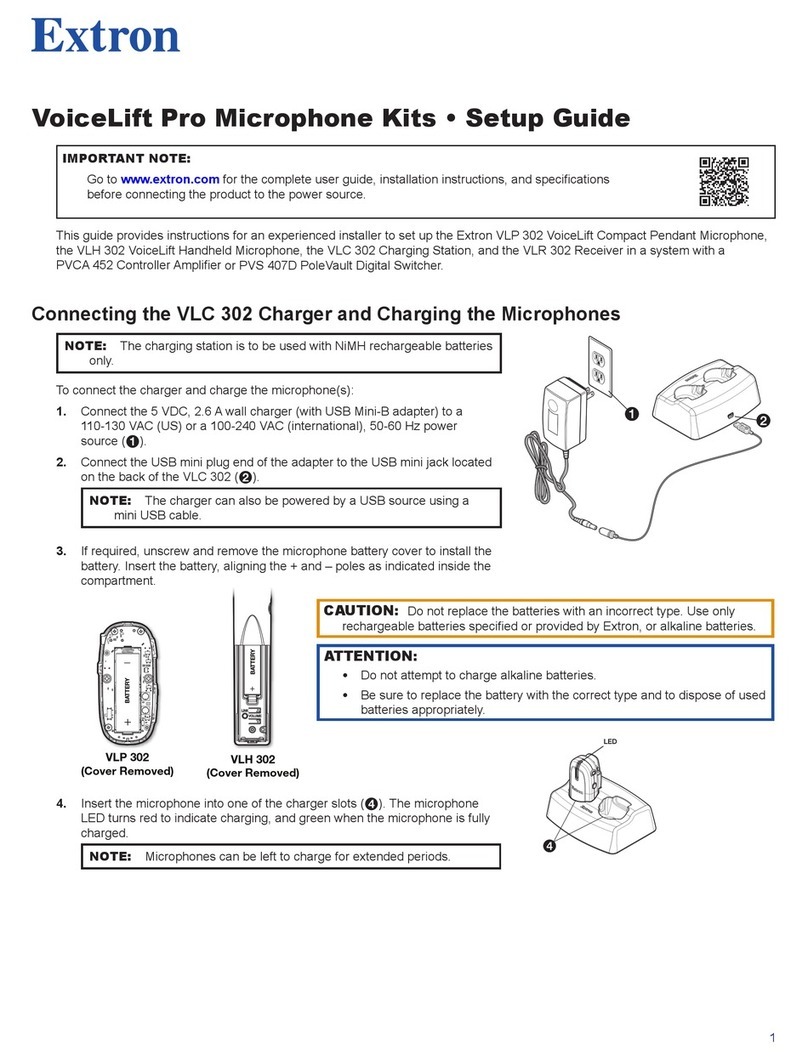
Extron electronics
Extron electronics VoiceLift Pro Setup guide
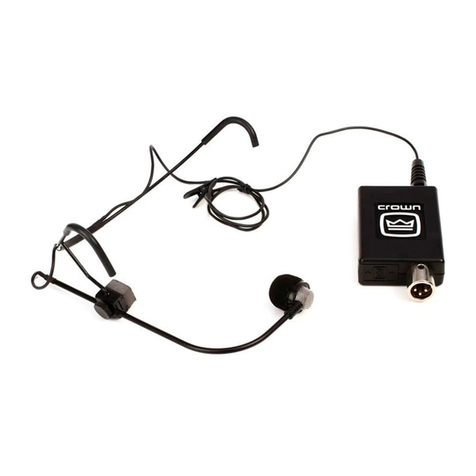
Harman
Harman Crown CM-311A quick start guide
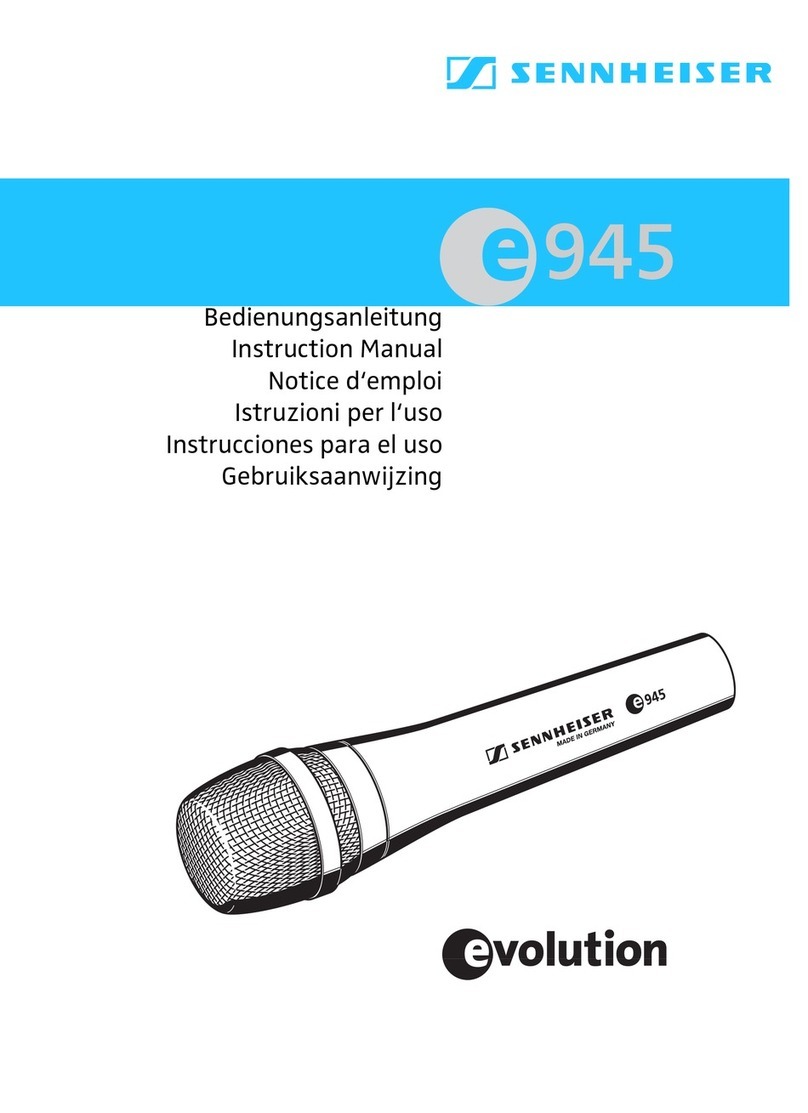
Sennheiser
Sennheiser evolution E945 instruction manual

IMG STAGE LINE
IMG STAGE LINE FSM-170 instruction manual

1 BY ONE
1 BY ONE 436na-0002 instruction manual
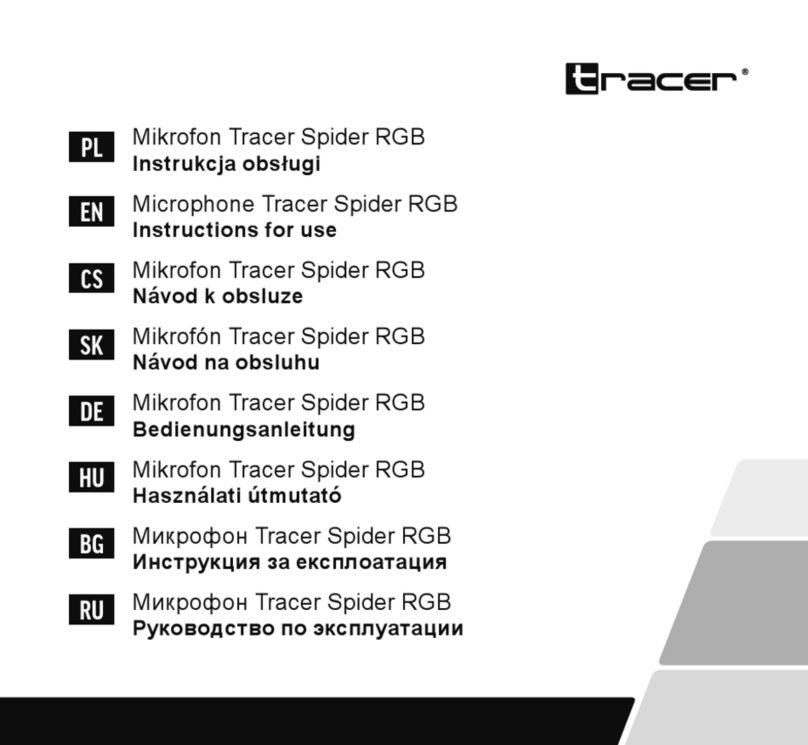
Tracer
Tracer Spider RGB Instructions for use
